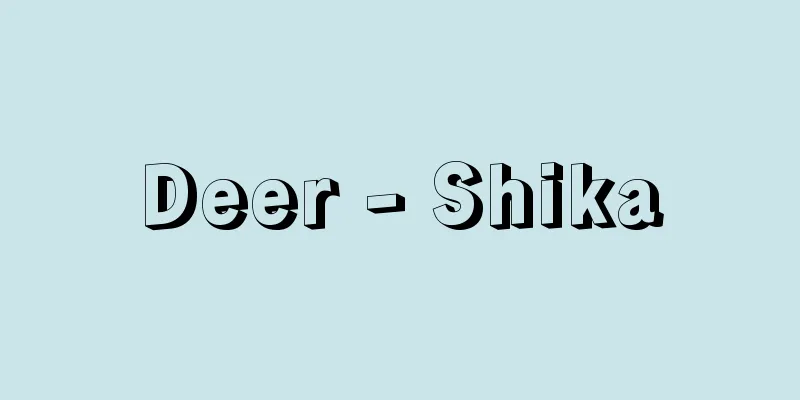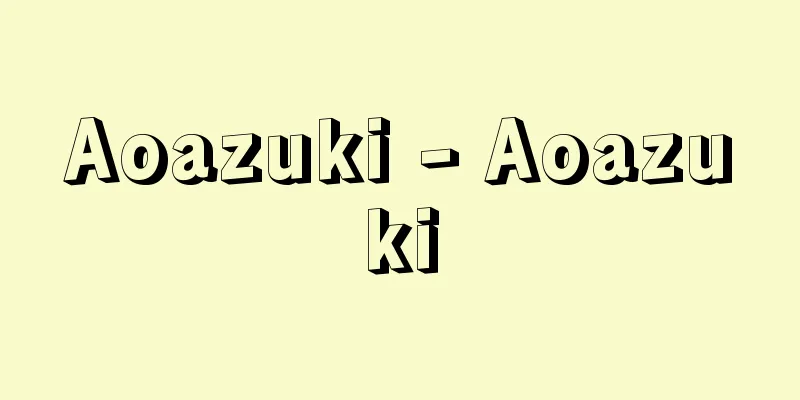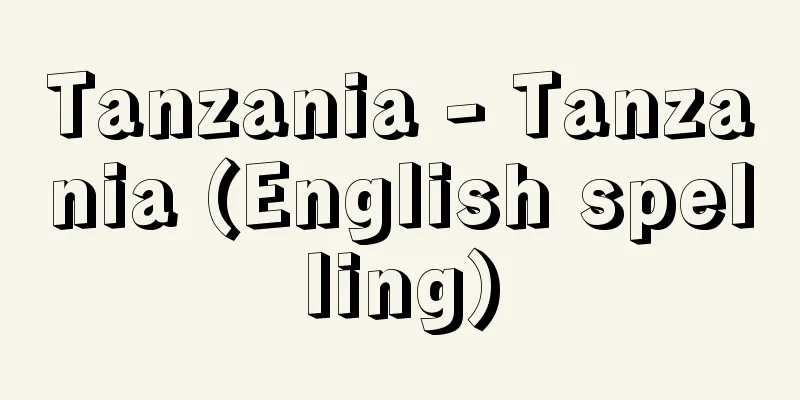Deer - Shika

|
〘Noun〙① (In the old days, male deer were called "seka" ( male deer ) in contrast to "female deer " (meka) , and it is said that this is a variation of that term) A general term for mammals belonging to the Cervidae family. They have slender bodies with long, thin limbs and short tails. Males usually have tree-like antlers on their heads that fall off from the base every year. They live in forests and grasslands, and eat tree and grass leaves and lichen. There are various species, including Japanese deer, reindeer, musk deer, muntjac, ovine deer and roe deer. In Japan, the term specifically refers to Japanese deer. Earnings. Scarecrow. Season: Autumn ※Nihon Shoki (720), Nintoku 38th year, July (Maeda Honin) "What is that stag? He answers, "It is a stag. He asks, "Where is this deer from?"② ( When the price was 16 momme, the "44" in 446 was sometimes stretched to "shishi (deer) " and written as " kakoi" (love of deer) .) Another name for "kakoi" ( enclosure ), a class of prostitute in Kamigata that was next to Tayu and Tenjin. ※Ukiyo-zoshi, Koshoku Nidai- otoko (1684), 5 "Yearning for the deer that does not know me."③ The leaves of the angelica tree that has grown. It is commonly said that if a deer eats this, its antlers will fall off. ※Kayo・Kanginshu (1518) "Na wo tsuma ba, sahaninezeriya, mine ni itadori, shika no tachikakure" [Etymology] (1)① is an animal hunted for food since ancient times, and together with boar, it was called "shishi", which means meat. To distinguish it from boar, it was called "kanoshishi" and also "kasegi". The "ka" common to these two seems to be a basic word meaning deer, but the relationship between "shika" and "ka" is unclear. (2) Deer often appear in ancient documents, but in waka poetry in particular, the voice of the male during the mating season in autumn is considered to be particularly charming, and since the "Manyoshu," they have often been combined with scenery such as bush clover and autumn leaves. From the late Heian period onwards, " tomoshi, " a type of deer hunting, also became a subject of waka poetry as a summer scenery. In addition, the fact that Kasuga Shrine, the guardian deity of the Fujiwara clan, respected deer as messengers of the gods also made deer closely related to Japanese culture. ka【deer】Roku [deer]Kasegi [deer]Source: The Selected Edition of the Japanese Language Dictionary About the Selected Edition of the Japanese Language Dictionary Information |
|
〘名〙① (古く、「女鹿(めか)」に対し雄じかを「夫鹿(せか)」と呼び、それが変化したものという) シカ科に属する哺乳類の総称。体はほっそりとし、四肢が細長く、尾は短い。ふつう雄の頭部には樹枝状の枝角があり、毎年基部から落ちる。森林や草原にすみ、木や草の葉・地衣などを食べる。ニホンジカ・トナカイ・ジャコウジカ・キョン・キバノロ・ノロなどの種類がある。日本では特にニホンジカをさしていう。かせぎ。かのしし。かかしし。《季・秋》※書紀(720)仁徳三八年七月(前田本訓)「其(かの)苞苴は何の物そ。対へて言はく、牡鹿(シカ)なり。問ひたまはく、何処(いつこ)の鹿(シカ)そ」② (揚代が一六匁のとき、四四十六の「四四」を「しし(鹿)」にこじつけ、「鹿恋(かこい)」の字を当てることがあるところから) 上方で太夫・天神につぐ遊女の階級、「囲(かこい)」の異称。※浮世草子・好色二代男(1684)五「我を見しらぬ鹿(シカ)にこがれ」③ 独活(うど)の生長して葉の伸び出たもの。鹿がこれを食うと角が落ちると俗にいう。※歌謡・閑吟集(1518)「なをつまば、さはにねぜりや、みねにいたどり、しかのたちかくれ」[語誌](1)①は古代からの食用狩猟獣で、猪と共に肉を意味する「しし」の語で呼ばれた。猪と区別して「かのしし」と呼び、また「かせぎ」ともいう。これらに共通する「か」が、鹿を意味する基本的な語のようだが、「しか」と「か」の関係は明らかではない。 (2)上代の文献からしばしば登場するが、特に和歌では秋の交尾期の牡の声が情趣あるものとされ、「万葉集」以来萩、紅葉等の景物とも組み合わされて多く詠まれた。鹿猟の一種「照射(ともし)」も平安後期以降、夏の景物として和歌の題材となった。なお、藤原氏の氏神である春日社が、神の使いとして尊重したことも、鹿と日本文化とを関係深いものとした。 か【鹿】ろく【鹿】かせぎ【鹿】出典 精選版 日本国語大辞典精選版 日本国語大辞典について 情報 |
Recommend
Offset printing machine - Ofusettoinsatsuki
...A machine that applies ink to a plate and pres...
Valvula cerebelli (English spelling) Valvula cerebelli
…the protocerebellum is involved in the organs of...
Gigas
…Giant race in Greek mythology. The singular form...
Shirokane [Hot Spring] - Shirogane
This hot spring is located in the southeastern par...
finances publiques (English spelling) financespubliques
…Since ancient times, public finance has been con...
Canton (flag) - Kanton
… [Hidetoshi Kato] [National flag specifications ...
Submarine cone
… canyon submarine canyon - a relatively narrow, ...
Caprilli, F.
...In the 19th century, Comte Antoine d'Aure ...
Ordinal scale
…An interval scale is a scale in which the differ...
mating call
…In the spring, frogs move from their habitats on...
Asian honeybee - Asian honeybee
…Both live in large family groups centered around...
Racing clock - Kyogidokei
A device used to instantly measure and display tim...
Primula nipponica (English name) Primulanipponica
… [Ken Inoue]. … *Some of the terminology that me...
Kyoto Kanze
Japanese sweets manufactured and sold by Tsuruya Y...
Tibicininae
…The subfamily Cicadas with complete sound organs...









